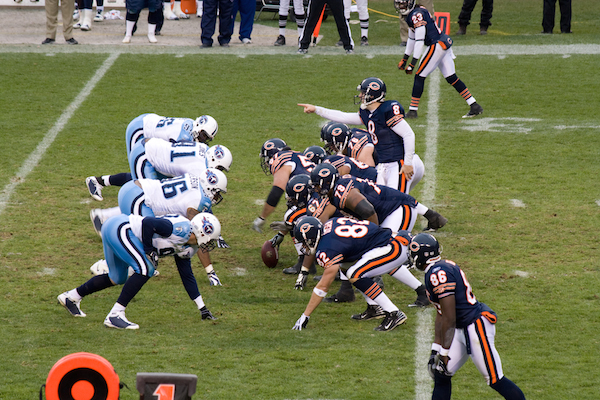Dear Sports Fan,
What is a false start in football? I get that it’s a penalty against the offense and that when it happens the play stops before it even starts but what I don’t understand is why it’s called or what a team can do to avoid it.
Thanks,
Chelsea
Dear Chelsea,
You’ve got most of it already but I’ll fill in the rest as best I can. A false start is a penalty in football that can only be called against the team with possession of the ball. The penalty for a false start is that the offense has to move the ball back five yards (or half the distance to their own goal line if they are within five yards of it) and start the play over again. A false start penalizes the offense if one of their players moves in an illegal way before the ball is snapped to start the play. One thing that’s cool about the penalty is that its inflexibility exhibits and reinforces one of the primary characteristics of football: it’s stop and start, tactical nature.
As we covered in our article answering What is a snap in football? every football play begins when the center snaps the ball backwards between his legs to another player. During the time before that happens, there are a separate set of rules that dictate what the teams on the field can do. For example, the offensive team is allowed to gather to talk (called a huddle) but not if there are more than eleven people in the group. The false start is a penalty in that set of rules that dictate what a team, specifically the one with the ball, can do before the ball is snapped. Roughly speaking, the offensive team is supposed to set themselves up in a particular way, pause, and then without moving, snap the ball to start the play. As you might expect, there are some technicalities and exceptions that dictate how this must happen: there must be at least seven offensive players set up right on the line of scrimmage (where the ball is set up at the start of the play); when the ball is snapped, one and only one player is allowed to be running around and he must be moving backwards or sideways and may not be one of the seven players set up on the line of scrimmage. The false start is called when one of a variety of things happen to violate these rules:
- A player in the offensive line “moves abruptly” once they are set up. This rule is so minute that even a flinch of the head will be called a false start.
- Any player on the offense moves “in such manner as to lead defense to believe snap has started.”
- The quarterback moves or acts in a way that is an “obvious attempt to draw an opponent offside”. (on this one, you might rightly be thinking that TV commentators often talk about quarterbacks trying to draw the defense offside by shouting like they are about to start the play. This is true but because those shouts could theoretically convey information to the quarterback’s teammates, they are allowed even though we all know exactly what they’re trying to do. It’s a conundrum wrapped in an enigma.)
The false start is one of the most typical penalties in football. No single penalty defines the sport as well as the false start. If you wanted to explain football to a fan of soccer or basketball or hockey or any number of other sports, the easiest way to do it would be to say that football is like those sports except that everything stops between plays. When a player is tackled or runs out-of-bounds, the teams have forty seconds to set up again for the next play. It’s a stop-and-start game. This makes it look boring to a lot of people used to the fluidity of other sports but it’s also responsible for the complexity and tactical interest that football and really only football of all the sports has. If football is a game where the teams are supposed to stop and then set up in a static way before starting again then the false start is the penalty that makes sure the offense has really stopped before they start the next play.
The false start also represents a failure of synchronization. The players on the offensive side of a football team train tirelessly to move in exact unison. A successful offense is one that moves with precision as one unit. You’ll often see quarterbacks pass the ball to a spot, knowing that by the time the ball gets there, their teammate will be there to catch the ball. Every successful offensive play is a triumph of moving in unison. When players move out of time with each other during a play, the play usually fails. When one player moves out of sync before the play begins, it’s a false start and their whole team is penalized. One of the funniest things to see on a football field is what happens when the one player who moves out of time is the player who starts the play with the ball, the center. When this happens, all his teammates move while he stays still. The mistake is really the center’s but because the play doesn’t start until he snaps the ball, the foul is officially called on his teammates, like this:
Thanks for the question,
Ezra Fischer
The Super Bowl is just around the corner. If you’d like to learn more about football, sign up for our Football 101 course to learn the basics of the game or Football 201 to learn all about football positions.

